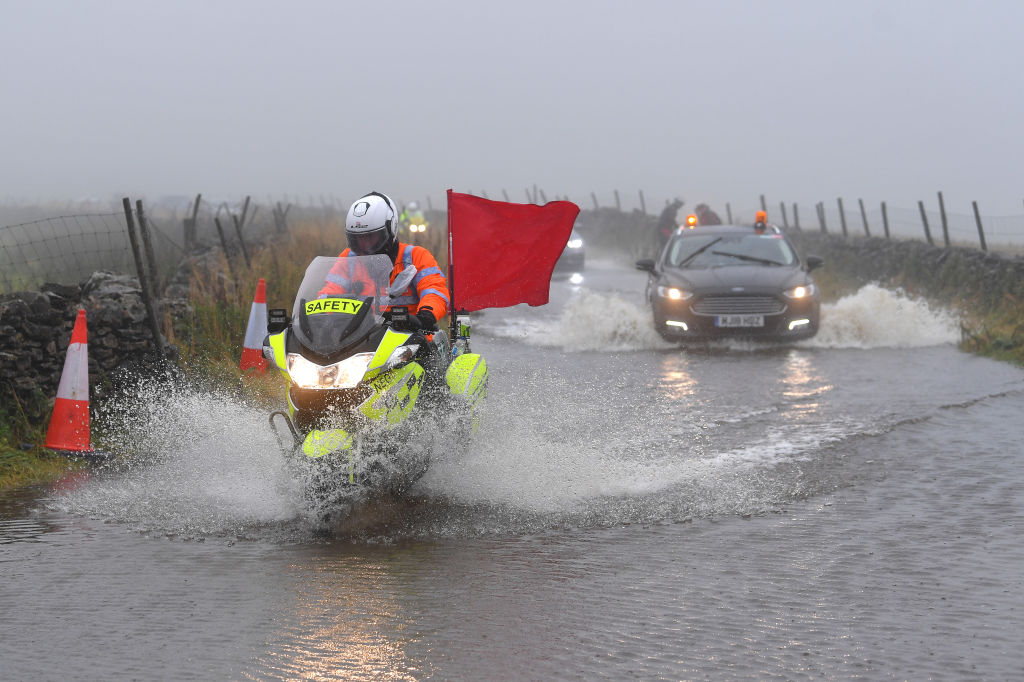Limited TV coverage causes frustration during elite men's road race at the World Championships
Low cloud cover grounds TV helicopters

Frustration mounted over the limited TV coverage caused by adverse weather conditions during the shortened 261km elite men's road race at the UCI Road World Championships on Sunday. Heavy rain and low cloud cover meant that the two helicopters carrying cameras weren't able to capture live pictures during the race.
"It's just extraordinary conditions today," a spokesperson from Yorkshire2019 told Cyclingnews. "We would have loved to show the helicopter shots. We've got the race, and land ads out in the fields. A lot of people have gone to a big effort and they are not getting the recognition they deserve.
"What can you do? This rain is extraordinary. It's out of our hands, unfortunately. It's extraordinary weather conditions."
The live coverage worsened when the race hit the finishing circuits in Harrogate, with roughly 120km to go, when motorbike cameras were rendered unusable. One of the two high-flying planes that transmits a signal to the motorbikes couldn't take off, while the other plane was required to land after roughly four hours to refuel. Live pictures didn't return until 75km remained.
That meant that for 45km of the final circuits, the only reliable cameras were the six static cameras located at various points along the 14km loop.
The Yorkshire2019 spokesperson explained that the European Broadcast Union (EBU) was responsible for the live coverage of the race; everything from the contracts with the UCI to the helicopters, equipment and timing of the races.
"It's not us; it's the EBU," the spokesperson said. "They work with the UCI and are the global producers. It's not so much Yorkshire2019. The EBU organises the planes, helicopters, cameras, all in collaboration with the UCI. The EBU syndicate that provides footage to the likes of the BBC and other broadcasters."
The latest race content, interviews, features, reviews and expert buying guides, direct to your inbox!
A banner that read "Due to bad weather conditions a limited coverage is in place" flashed across television screens. Race commentators informed viewers of the issues surrounding the limited TV coverage due to grounded helicopters, the refuelling of the plane and the use of static cameras.
"We had two helicopters, and they try and get the images, but because the clouds were so low they couldn't fly," said the Yorkshire2019 spokesperson. "They could go in the air, but they couldn't go under the clouds to get the pictures.
"Above them, in every race, there is a plane that flies above the helicopters to transmit a signal. That plane can only be in the air for a certain amount of time before it needs to refuel. It had to land to refuel.
"That's why we had the loss of the live footage because the motorbike cameras need that signal from the plane above."
Many questioned why the plane didn't start coverage later in the race so that it didn't interrupt coverage of the more decisive finishing circuits to refuel.
The motorbike cameras stopped running with 120km to go, just as the breakaway entered the first circuit. They captured the crucial moment where Belgium's Philippe Gilbert had crashed. However, the footage abruptly switched to the static cameras on course for the next three laps and viewers were left with spotty coverage wondering what was happening in the race.
"This is not uncommon," said the Yorkshire2019 spokesperson. "Other international races have had the same problems with cloud cover and helicopters not being able to get the pictures. We experienced it ourselves with the 2016 Tour de Yorkshire with a similar problem.
"When that happens typically, that's when you revert to the motorbike cameras and then still cameras, and you don't notice when it happens.
"If you've been watching today, for the last three hours, the pictures are there. The commentators don't normally draw attention to [the limited TV coverage] and there aren't normally banners across the screen pointing it out.
"We have five or six static camera points around the circuit; on Parliament Street, a few on the finishing straight, one where they turn onto the circuit, and two more on the climbs on Penny Pot Lane and Oak Beck climb. But it doesn't give blanket coverage of the whole 14km.
Once the plane refuelled and took flight it was able to transmit the signal to and from the motorbike cameras that went back out on course to cover the final six laps of the race.
Following the race, the UCI released communication regarding both the two planes and the two helicopters.
"This year we’ve enhanced the live broadcast setup with two planes and two helicopters in order to carry the signal from the motorbike. Due to particularly bad weather conditions the two helicopters haven’t yet received the authorization to fly by local civil aviation authorities.
"The backup plane has to be used as the other one has to face a mechanical issue earlier this morning. This plane had to refuel earlier today in Leeds and is now back on the course allowing moto camera images for the last and decisive part of the race.
"During this time broadcast has been based on fixed camera on circuit, alternating with footage from motos and highlights from morning racing."
Heavy rain in Yorkshire forces organisers to use contingency plans
Yorkshire2019 and the UCI have been putting contingency plans to use throughout the eight days of racing at the UCI Road World Championships. Heavy rain caused dangerous sections of standing water during the under-23 men's time trial and a delay in the elite women's time trial on Tuesday.
The UCI also shortened the under-23 men's road race due to safety concerns and need for better natural light for live television broadcasts on Friday.
The sports governing body announced on Sunday morning that it had to alter and shorten the elite men's road-race route by 23.5km to 261km due to a forecast of severe weather conditions. Two additional laps of the finishing circuit in Harrogate had also been added to the course.
"We've been planning this for months and months," said the Yorkshire2019 spokesperson. "We have had training exercises - crisis comms - which is what you saw today. Those plans definitely have been put in place for months. Numerous training exercises, but we've had exceptionally hard rain and it's autumn, all the leaves are falling from the trees. It's an imperfect storm.
"We've got the councils, highways agencies, and they are absolutely all at capacity. It's not like we're at a football stadium. We've got 280km of roads to prepare, which is a mammoth undertaking because it's going through different local authorities, so they have to work together.
"It's a massive operation. This is the way it is I'm afraid."

Kirsten Frattini is the Deputy Editor of Cyclingnews, overseeing the global racing content plan.
Kirsten has a background in Kinesiology and Health Science. She has been involved in cycling from the community and grassroots level to professional cycling's biggest races, reporting on the WorldTour, Spring Classics, Tours de France, World Championships and Olympic Games.
She began her sports journalism career with Cyclingnews as a North American Correspondent in 2006. In 2018, Kirsten became Women's Editor – overseeing the content strategy, race coverage and growth of women's professional cycling – before becoming Deputy Editor in 2023.